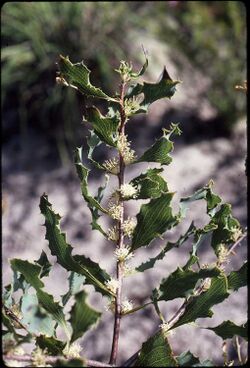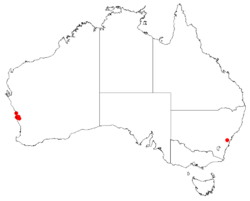Biology:Hakea neurophylla
| Pink-flowered hakea | |
|---|---|

| |
| Hakea neurophylla in Kings Park | |
| Scientific classification | |
| Kingdom: | Plantae |
| Clade: | Tracheophytes |
| Clade: | Angiosperms |
| Clade: | Eudicots |
| Order: | Proteales |
| Family: | Proteaceae |
| Genus: | Hakea |
| Species: | H. neurophylla
|
| Binomial name | |
| Hakea neurophylla Meisn.[1]
| |

| |
| Occurrence data from AVH | |
Hakea neurophylla, commonly known as the pink-flowered hakea,[2] is a shrub of the genus Hakea native to a small area near Dandaragan in the Wheatbelt region of Western Australia.[3]
Description
An erect non-sprouting shrub typically grows to a height of 0.3 to 2 metres (1 to 7 ft). Racemes of fragrant blooms appear from July to August in profusion in white or pale pink-red along the branchlets in the leaf axils. Inflorescences are solitary with 12 to 18 scented flowers with glabrous pedicels. Blue-grey leaves are obovate to elliptic and sometimes undulate 5 to 11 centimetres (2 to 4 in) long and 16 to 43 millimetres (0.6 to 1.7 in) wide and narrowly cuneate at the base. Leaves have 3 prominent longitudinal veins on both sides ending in a blunt point. Large blackish-brown fruit are obliquely ovate, from 3 to 4 centimetres (1.2 to 1.6 in) long and 1.5 to 1.9 centimetres (0.6 to 0.7 in) wide, obscurely beaked, with a dorsal longitudinal ridge on each valve.[4][5]
Taxonomy and naming
Hakea neurophylla was first formally described by Carl Meisner in 1855.[6] Named from the Greek word neuron - nerve and phyllon leaf, a reference to the prominent veins in the leaves.[5]
Distribution and habitat
Hakea neurophylla is a rare species restricted to the Mt Lesueur - Eneabba area north of Perth in heathland sand over laterite usually on ridge tops.[7][5]
Conservation status
Hakea neurophylla is classified as Priority Four - Rare by the Western Australian Government Department of Parks and Wildlife.[3]
References
- ↑ "Hakea neurophylla". https://biodiversity.org.au/nsl/services/apc-format/display/97287.
- ↑ "Hakea neurophylla Pink-flowered Hakea". Nindethana Seed Company. 2016. http://www.nindethana.net.au/product-detail.aspx?p=2298.
- ↑ 3.0 3.1 "Hakea neurophylla". FloraBase. Western Australian Government Department of Parks and Wildlife. https://florabase.dpaw.wa.gov.au/browse/profile/2186.
- ↑ Young, J A. Hakeas of Western Australia:A Field and Identification Guide. J A Young. ISBN 0-9585778-2-X.
- ↑ 5.0 5.1 5.2 "Hakea neurophylla". http://www.flora.sa.gov.au/efsa/lucid/Hakea/key/Australia%20Hakea%20species/media/Html/Hakeaneurophylla.htm.
- ↑ "Hakea neurophylla". https://id.biodiversity.org.au/instance/apni/522377.
- ↑ Holliday, Ivan. Hakeas of Western Australia: A Field and Identification Guice. Reed New Holland. ISBN 1-877069-14-0.
Wikidata ☰ Q18080132 entry
 |


